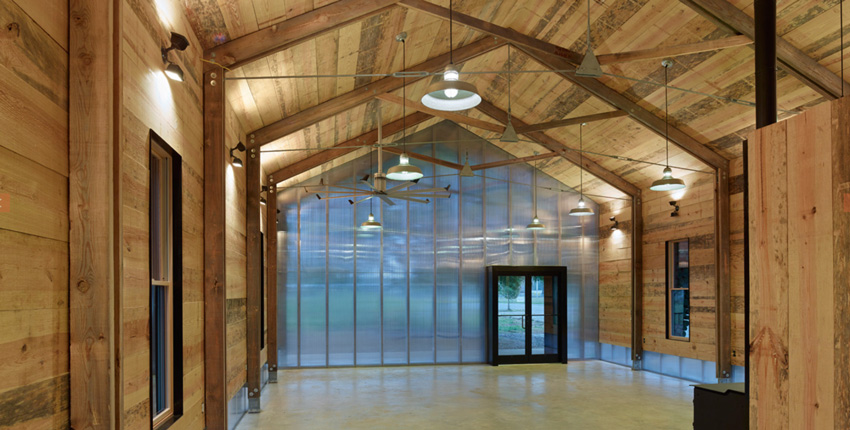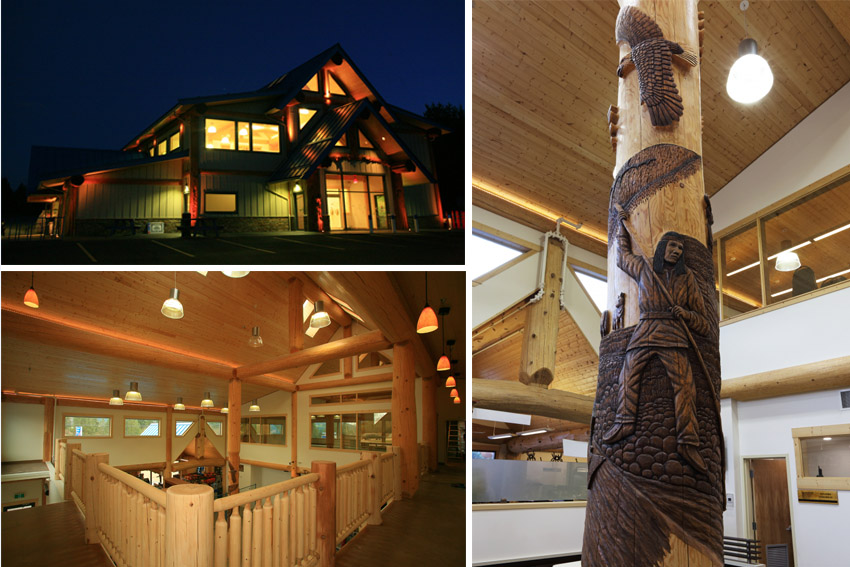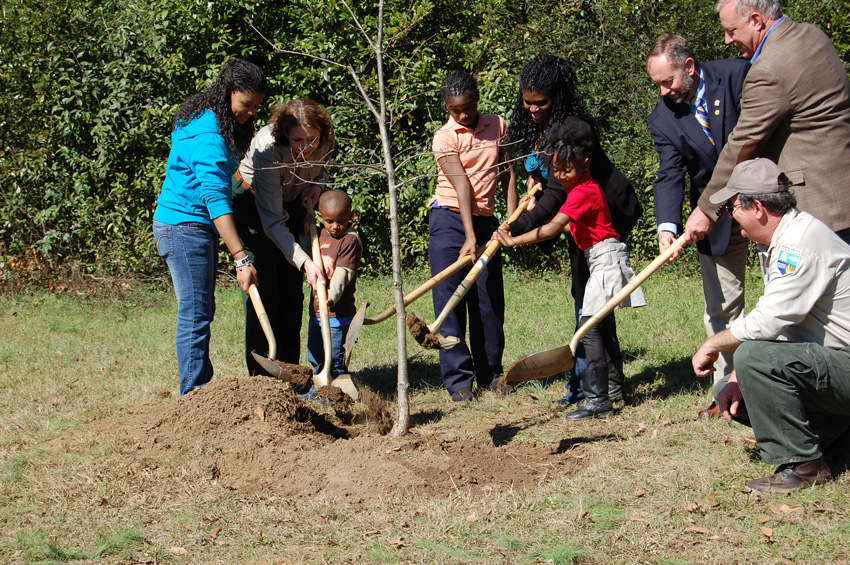Creating a New Path for Forest Products In Green Buildings
How to Document SFI Wood and Paper for the LEED ACP
It is important for builders, architects, building owners, and/or building operators to easily locate and source products certified to the SFI standards. There are essentially three ways to document whether or not the wood or paper comes from SFI, CSA, and/or ATFS forest management. But it’s important to note that ATFS and CSA are forest management standards and do not have their own label or chain-of-custody program. The fiber from forests certified to ATFS and CSA is delivered to market through an SFI chain-of-custody and SFI label. In addition, fiber from any forest management standard endorsed by PEFC can be delivered to market through a PEFC chain-of-custody and PEFC label.
Three documentation methods
- An on-product label: The SFI program has on-product labels to help architects, builders, and operators identify exactly what they are buying. SFI has an SFI Certified Sourcing label and an SFI Chain-of-Custody label.
- If a LEED user sees the following SFI Certified Sourcing label, the product meets the “legal” and “responsible” categories.
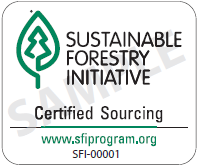
- If a LEED user sees the following SFI Chain of Custody label, the product meets the “legal,” “responsible,” and “certified” categories as described in Figure 2.
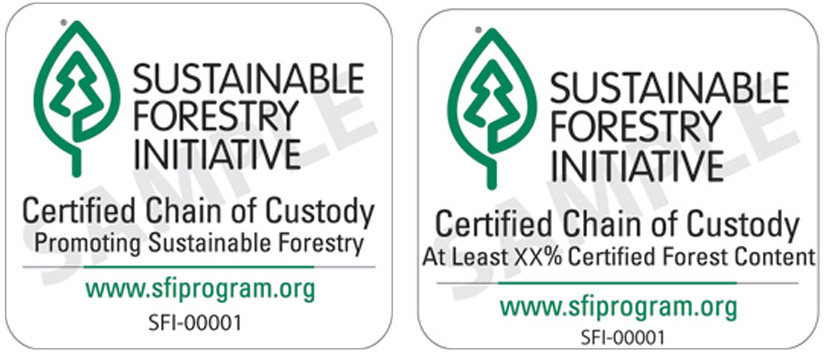
- If a LEED user sees the following SFI Certified Sourcing label, the product meets the “legal” and “responsible” categories.
- SFI Database: SFI also maintains a list of all certificate holders. The only way a company will show up in this database is if that company is certified. If the certificate is revoked or suspended, the company will not appear in the database.
- The SFI fiber sourcing database will verify if the company meets the “legal” and “responsible” categories as defined in the ACP. (Database: http://64.34.105.23/PublicSearch/SearchFiberSourcingCertificates.aspx)
- The SFI chain-of-custody database will verify if the company meets the “legal,” “responsible,” and “certified” categories as defined in the ACP. (Database: http://64.34.105.23/PublicSearch/SearchCertificate.aspx)
- Certificate from supplier: The final way an architect, builder, or operator can verify “legal,” “responsible,” or “certified” sources as defined by the ACP is through the sale of a product. Each company certified to SFI is issued a certificate by the certification body that conducted the audit.
- If the certificate states certified to the SFI 2015-2019 Fiber Sourcing Standard, then that product qualifies for the “legal” and “responsible” categories.
- If the certificate states certified to the SFI 2015-2019 Chain of Custody Standard, then the organization must communicate the fiber inputs in the product. Product sold with an SFI certified forest content claim qualifies for the “legal,” “responsible,” and “certified” categories.
Putting Forests First
As these important steps are taken to protect the forests that are a renewable source of a key sustainable building material, a multitude of other benefits will follow. The forests have significant economic value to the industries and communities that rely on them and the millions of people who work there.
But forests are meaningful to humans for many reasons beyond their monetary value. Most people have experienced this connection, but scientific research has also demonstrated that green places improve human health and well-being.7 About 95 percent of forests certified to SFI are available for recreation, hunting, fishing, birdwatching, camping, and just enjoying nature.
Forests also provide habitat for a diversity of species. So it is in everyone’s interest to build a strong foundation for healthy forests by promoting conservation and community, and teaching a new generation to be environmental guardians.
Healthy, thriving forests need management and oversight. This is essential to prevent illegal, destructive and the, unfortunately, widespread exploitation of unmanaged forests. Forest management is also key to mitigating the effects of increasing wildfires and disease due to climate change. The SFI Forest Management Standard requires sustainable harvest levels, reforestation, measures to protect water quality, biodiversity, wildlife habitat, species at risk, and Forests with Exceptional Conservation Value.
Unique to the SFI Program is the SFI Conservation and Community Partnerships Grants Program, which was founded in 2010. These grants help foster research and pilot efforts to better inform future decisions about forests and to help innovative community efforts grow. In total, the program has awarded 50 conservation grants and 35 community partnership grants totaling more than $3 million. When leveraged with project partner contributions, the total investment is $9.5 million. Past projects have included research to better understand the nutrition requirements of woodland caribou, supporting longleaf pine ecosystem restoration in the southern United States, and developing best practices for bird habitat management in forests of the northeastern United States and Rocky Mountain regions.
SFI is the only forest certification standard in North America that requires participants to support and engage in research activities to improve forest health, productivity, and sustainable management of forest resources. Since 1995, SFI program participants have invested more than $1.3 billion in forest research activities. Recent research grants focus on forest health and productivity (50 percent), water quality (6 percent), wildlife and fish (9 percent), landscape/ecosystem management and biodiversity (14 percent). The remaining 21 percent of research projects include topics like energy efficiency and life-cycle assessment studies.
The SFI program is a 20-year-old organization based on a guiding principle of continuous improvement. SFI works at the intersection of sustainable forests, thriving communities, and responsible procurement. Over the past 20 years, SFI has tightly aligned its own program goals with LEED’s seven impact goals that include reversing climate change, enhancing human health, protecting water resources and biodiversity, promoting sustainable material resources, building a greener economy, and enhancing social equity and community quality of life. The evidence of this is seen in SFI’s standards, programs, and initiatives.
End Notes
1O’Connor, Jennifer and Sathre, Roger. A Synthesis of Research on Wood Products & Greenhouse Gas Impacts, Second Edition. FPInnovations, 2010.
http://woodworks.org/wp-content/uploads/FPI-Greenhouse-Gas.pdf.
2Puettmann, Maureen E. et al. “Cradle-To-Gate Life-Cycle Inventory of U.S. Wood Products Production: Corrim Phase I And Phase II: Products.” Wood and Fiber Science, 2010. Updated January 2013.
http://www.corrim.org/pubs/reports/2013/phase1_updates/index.asp.
3McPherson, Gregory E. et all. “Northeast Community Tree Guide: Benefits, Costs, and Strategic Planting.” August 2007.
http://www.fs.fed.us/psw/publications/documents/psw_gtr202/psw_gtr202.pdf.
4McPherson, Gregory E. “Urban Forest Research.” March 2001.
http://www.fs.fed.us/psw/programs/uesd/uep/products/newsletters/UF1.pdf.
5Nellemann, C. Green Carbon, Black Trade: Illegal Logging, Tax Fraud and Laundering in the World’s Tropical Forests. UNEP and INTERPOL, 2012.
http://www.unep.org/pdf/RRAlogging_english_scr.pdf.
6Baccini, A. et al. “Estimated carbon dioxide emissions from tropical deforestation improved by carbon-density maps.” 29 Jan. 2012.
http://www.nature.com/nclimate/journal/v2/n3/full/nclimate1354.html.
7Harvey, Chelsea. “Why living around nature could make you live longer.” The Washington Post. 19 April 2016.
https://www.washingtonpost.com/news/energy-environment/wp/2016/04/19/why-living-around-nature-could-make-you-live-longer/.
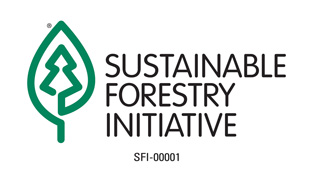
|
SFI® Inc. is an independent, nonprofit organization that is solely responsible for maintaining, overseeing and improving the internationally-recognized SFI program. SFI works at the intersection of sustainable forests, thriving communities and responsible procurement and works collaboratively with conservation groups, local communities, resource professionals, landowners and countless other organizations and individuals who share our passion for and commitment to responsible forest management. SFI Inc. is governed by a three-chamber board of directors representing environmental, social and economic sectors equally. Learn more at sfiprogram.org. |




